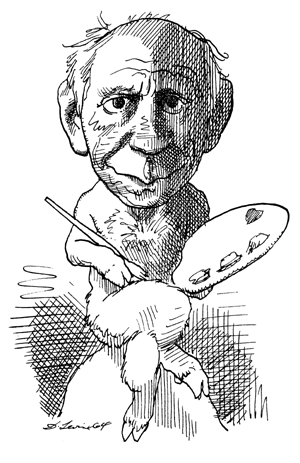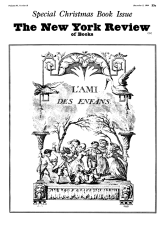Everything about Picasso is interesting. Even the most trifling facts of his personal life turn out to be valuable clues which explain his unpredictable changes of subject, style, or mood. If, for instance, he is prevented from going to the bull-fight of a Sunday, he will console himself by doing drawings of a corrida. If he acquires a new mistress, her presence will at once be reflected in his work—in still lifes as well as figure paintings. If he acquires a new dog, there will be pictorial repercussions. All this puts the student of Picasso’s art in an embarrassing dilemma. His understanding of what goes on in the studio will inevitably depend on his knowledge of what is happening elsewhere—not just in the house but on the street and out in the world. For this information he has to rely on books by Picasso’s intimate friends. Some are most useful, others are not always reliable. Take the present volume.
On the face of things, Françoise Gilot should be an invaluable source of information. For ten crucial years (1943-53), during which Picasso revolutionized the technique of lithography and the craft of pottery and also executed vast numbers of paintings, drawings, and sculptures, she was his mistress. She has the advantage of a painter’s eye, a retentive memory, and a sharp—jaggedly sharp—mind. No less important, she has been seconded by a ghostwriter who is self-effacing and literate compared to most.
A more questionable advantage is Madame Gilot’s evident lack of scruple. Far from being deterred by feelings of delicacy, she sticks pins indiscriminately in friend and foe and mercilessly rattles the skeletons in any closet to which she has the key. In Life with Picasso the artist’s complicated relations with family, mistresses, friends, colleagues, and dealers, not to speak of his private business arrangements and even his sexual habits, are unveiled to the public with such relish that one sometimes wonders why this book was serialized in the Atlantic Monthly and not in Confidential.
Indiscretion masquerading as candor is not an endearing trait in a writer. Nor is the apparent chip-on-shoulder malice which permeates—and ultimately invalidates—much of this book. Instead of showing us “the most intimate and revealing” portrait of the greatest artist of our time, as the blurb claims, Madame Gilot has concocted the caricature of a petty tyrant. Even Picasso’s generosity is impugned. For example, this sour account of how the artist presented a memorial to the City of Paris In memory of Guillaume Apollinaire:
…By now Pablo was thoroughly disgusted and lost all interest in the project…he simply gave them a sculpture that was lying around the studio, a bronze head of Dora Maar that he had done in 1941.
In due time the committee had it set up in the little square under a tree particularly favored by the local sparrows. There it stands today, encrusted with their droppings, less a monument to the memory of Apollinaire than another ill-starred tribute from its maker to Dora Maar.
Characteristically Madame Gilot fails to tell us that this studio discard (why “ill-starred”?) is in fact a head of heroic proportions: one of Picasso’s finest and $$$ sculptures and among the most important twentieth-century monuments to be seen in the streets of Paris. Surely a most worthy memorial to a great poet!
And here she goes again with her smear-gun—the discarded favorite at her most wronged:
After I returned to Paris, I never saw Pablo again. I did hear from him indirectly from time to time: for example, in the spring I was not invited to exhibit at the Salon de Mai. And the next fall, a week after I returned from the clinic with a new daughter, Aurélia, I had a letter from Kahnweiler terminating my contract with him.
That these innuendoes are without foundation, anyone who makes the necessary enquiries will discover. If Madame Gilot is seriously under the delusion that Picasso was responsible for her misfortunes, why dedicate this book to him? Or is she simply out to add insult to injury?
This volume would carry more conviction if Madame Gilot were less disingenuous—about politics, for instance. Picasso is portrayed—incorrectly—as a starry-eyed intellectual who was converted to Communism by Laurent Casanova, with some help from Aragon and Eluard. Later we are told how Picasso was “martyrized” by the Party, apparently because “every time the Communists came to eat with us, each one ate enough for four.” And the author goes on to castigate Mourice Thorez: “the Party chief was such a bore [her italics]: he never knew what to say.” Significantly Madame Gilot passes over her own political views in silence. Why? Might not knowledge of these shake our faith in her superior attitude? After all, the years covered by this book are the period of Picasso’s maximum political commitment.
Advertisement
And then the embarrassing matter of Picasso’s infidelities. Madame Gilot goes into these peccadilloes with a great show of virtue, but she casts a blackout curtain over the circumstances of her own relationships at the time. More than any other, this omission shakes one’s faith in the author, especially in her account of the end of the Picasso affair. The accusations which Madame Gilot makes against the artist would be more convincing if she were less evasive and contradictory about her own moves. For instance, was her action in walking out on Picasso—a climax she is careful to play down—intended to be irrevocable or not?
By suppressing certain things, by heightening others and by denigrating virtually everyone in the Picasso milieu, Madame Gilot seeks to build up a case for herself as the brave and innocent young victim of an old man who, for all his genius, turned out to be a “Bluebeard”: miserly and promiscuous, ruthless, self-pitying, and cruel. The more she protests, however, the more one feels that the boot was often on the other foot. Picasso is moody and demanding—genius has every right to be—but he is infinitely more human, generous, and thoughtful than the author suggests.
Nor are his friends the abject lackeys that Madame Gilot depicts. Heaven knows, they did not take to her, but that is no reason to dismiss Sabartes, Picasso’s devoted secretary, as a ludicrous Don Bartolo; Madame Ramié, his devoted céramiste, as an intriguing Marcellina; Marcel, his devoted exchauffeur, as a conniving Figaro; and Inès, his devoted maid, as a cheeky soubrette. Another favorite of Picasso’s, Alice Toklas, turns up as the witch out of Hansel and Gretel. Madame Gilot’s predecessors in Picasso’s life, Olga Picasso and Dora Maar, fare even worse: the former turns out to have been a dangerous lunatic, the latter a religious fanatic. Kahnweiler, Picasso’s dealer, also comes in for a lot of punishment, some of it well below the belt.
No more are painters and poets spared by the author’s acid nib. Matisse is surprised in a moment of senile love-play. Chagall, Léger, Miró, Cocteau, Eluard, Gertrude Stein, and the Aragons are all cut down to size—sometimes in Madame Gilot’s words, sometimes in Picasso’s. For, when comments fail her, the author does not hesitate to trot out one of her ex-lover’s more waspish boutades. This breach of confidence is the more unconscionable, as Picasso loathes any public divulgence of his private views, especially when this might hurt old friends or colleagues.
Inevitably much of the mud sticks to the author’s hands. What hypocrisy! one feels. Small wonder Picasso was so impatient with her. If only he would tell his side of the story! Life with Françoise, according to those who have heard the artist’s account, was a bed of anything but roses. Actually we can to some extent follow events from Picasso’s angle in terms of the portraits that he did of Françoise—far more eloquent evidence than anything she puts forward. It is a sad tale. In his first portraits Picasso sees his new love as a flower or classical nymph; these are wonderfully touching and tender. But a change soon comes: for all their variety and brilliance, the portraits of the late Forties tend to be schematic or matter-of-fact. Then, as love evaporates, Françoise’s appearance becomes progressively more bleak and angular, until at the very end Picasso depicts the erstwhile jeune fille en fleur as a predatory shrew. These last pictures leave us in no doubt as to the nature of the artist’s feelings. After the break-up comes the post-script: the so-called Verve series of 180 drawings in which Picasso comments with humor and detachment on the plight of an old man involved with a young model. In the most poignant of these masked figures confront one another; the young girl’s mask conceals an old ogre. Beauty turns out to have been a Beast.
Why did this unhappy affair drag on for so long? There were of course two children. And for the first four years or so Picasso was very much in love with Madame Gilot. But this book provides only the most paltry evidence of her love for him. The author puts forward another reason: there was nobody else around with whom Picasso could discuss painting. But this is to overlook Eluard and Pignon, a great friend who is conspicuously absent from these pages.
And how about these discussions between Picasso and the author? On different occasions he explained to Madame Gilot all about Cubism, the Vollard series of engravings, his approach to portraiture, and much else besides. All this is recapitulated at length by Madame Gilot between inverted commas. Still, I must confess forebodings which are not allayed by Carlton Lake’s Foreword.
Advertisement
I have been continuously impressed by her demonstration of the extent to which that much abused term “total recall” can be literally true. Françoise knows exactly what she said, what Pablo said, every step of the way for the ten years and more that they spent together.
“Exactly?” Can one really believe that the complex dissertations which the authors put into Picasso’s mouth are exactly what he said, fifteen and twenty years ago?
For me, at any rate, they never have the ring of real talk, let alone of Picasso’s talk. Picasso’s conversation is far more spontaneous and brilliant. He eschews logic and abhors pretentious jargon (“psycho-physiological dynamism” is utterly unlike him). When he is in good form he leaps from image to image, aphorism to aphorism, and paradox to precept. One is dazzled, charmed, provoked, occasionally appalled; one is never bored. And, let us face it, Madame Gilot’s lecturettes tend to be boring. Far be it from me to question the authenticity of these dicta; the trouble is simply that the authors have not got what it takes to turn the dust of memory back into something fresh and savorous. Even if they had, could we exonerate this wretched book? Françoise Gilot had the good fortune to be loved by the most inventive and creative artist of this century—perhaps of all time. Instead of concentrating on the splendors of her life with Picasso, and thus heightening her readers’ understanding of art and life, she harps on the petty miseries. In so doing she demeans only herself.
This Issue
December 3, 1964




